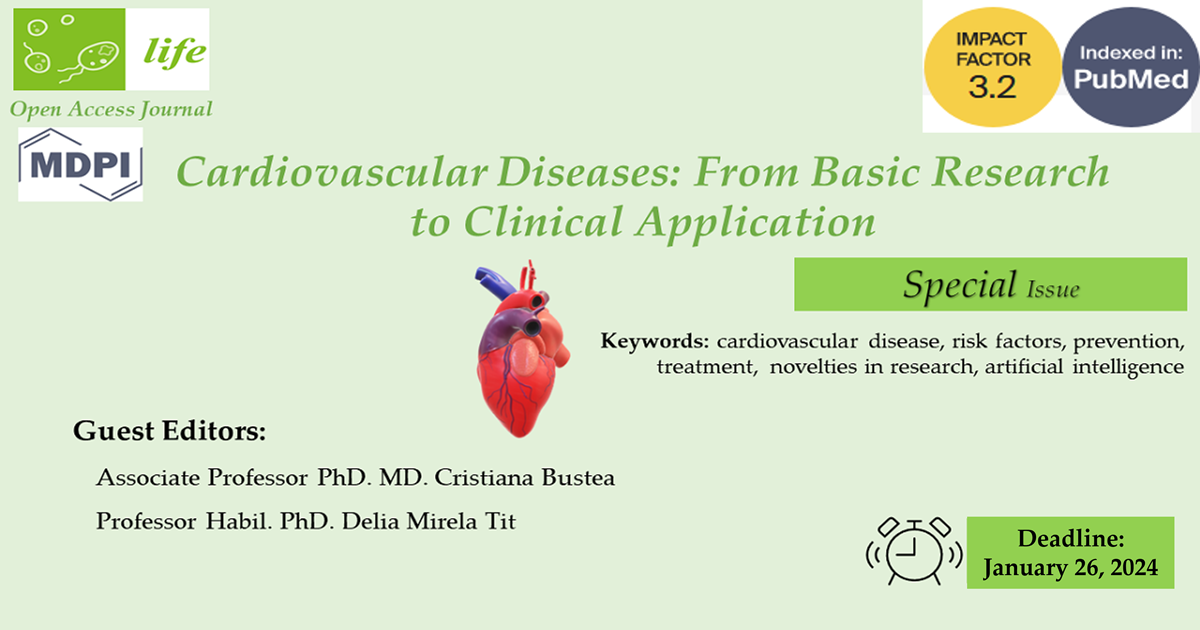- 3.4Impact Factor
- 6.0CiteScore
- 20 daysTime to First Decision
Cardiovascular Diseases: From Basic Research to Clinical Application
This special issue belongs to the section “Medical Research“.
Special Issue Information
Dear Colleagues,
Presently, cardiovascular disease (CVD) is the most prominent threat to human health. Because CVD is still the leading cause of death, research in this field is a critical task. Although recent decades have seen tremendous progress regarding the risk factors of CVD, the molecular basis of atherosclerosis, coronary revascularization, and the treatment of heart failure (among others), much remains to be done, and the prospects are promising. In order to improve the quality and length of life for those at risk of CVD, research for better predictors of this disease and better means for prevention and treatment must be the target.
The purpose of this Special Issue is to identify several important advances in clinical and basic research in CVD that will provide the tools for further progress in the prevention and treatment of this disease. As artificial intelligence plays an increasingly important role in the prevention of CVD, it may be worth having a look at this particular field.
Therefore, it is our pleasure to invite all researchers with interest in CVD research and who are willing to be part of this Special Issue project to publish papers that address novelties in both clinical and basic cardiovascular research. We encourage the submission of all types of manuscripts including original studies, reviews and short communications
Dr. Cristiana Bustea
Prof. Dr. Delia Mirela Tit
Guest Editors
Manuscript Submission Information
Manuscripts should be submitted online at www.mdpi.com by registering and logging in to this website. Once you are registered, click here to go to the submission form. Manuscripts can be submitted until the deadline. All submissions that pass pre-check are peer-reviewed. Accepted papers will be published continuously in the journal (as soon as accepted) and will be listed together on the special issue website. Research articles, review articles as well as short communications are invited. For planned papers, a title and short abstract (about 250 words) can be sent to the Editorial Office for assessment.
Submitted manuscripts should not have been published previously, nor be under consideration for publication elsewhere (except conference proceedings papers). All manuscripts are thoroughly refereed through a single-blind peer-review process. A guide for authors and other relevant information for submission of manuscripts is available on the Instructions for Authors page. Life is an international peer-reviewed open access monthly journal published by MDPI.
Please visit the Instructions for Authors page before submitting a manuscript. The Article Processing Charge (APC) for publication in this open access journal is 2600 CHF (Swiss Francs). Submitted papers should be well formatted and use good English. Authors may use MDPI's English editing service prior to publication or during author revisions.
Keywords
- CVDs
- risk factors
- prevention
- treatment
- novelties in research
- artificial intelligence

Benefits of Publishing in a Special Issue
- Ease of navigation: Grouping papers by topic helps scholars navigate broad scope journals more efficiently.
- Greater discoverability: Special Issues support the reach and impact of scientific research. Articles in Special Issues are more discoverable and cited more frequently.
- Expansion of research network: Special Issues facilitate connections among authors, fostering scientific collaborations.
- External promotion: Articles in Special Issues are often promoted through the journal's social media, increasing their visibility.
- e-Book format: Special Issues with more than 10 articles can be published as dedicated e-books, ensuring wide and rapid dissemination.

